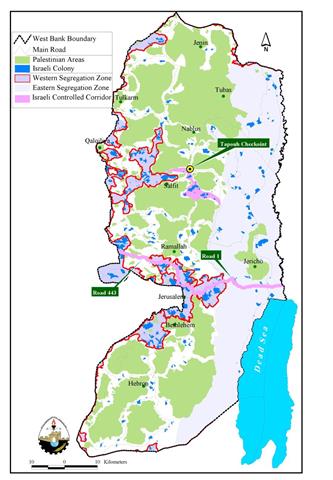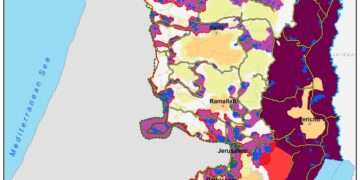It seems that Israel's plans do not stop at snatching 10% (565 Km2) along the western terrains of the occupied West Bank territory with the ongoing – near complete construction of the Segregation Wall and the isolation of 29% (1664 Km2) along the eastern terrains, but it breaks up the area remaining 'in between' into three regions (north, central & south); separated from each other by two Israeli controlled corridors enclosing Israeli settlements clusters, earth mounds, cement blocs, popup checkpoints and permanent checkpoints. The northern region will include the four Palestinian Governorates; Jenin, Nablus, Tulkarem and Qalqilyia; the central region will include Ramallah and Jericho Governorates; whereas the southern region will include Bethlehem and Hebron Governorates. As for East Jerusalem, the Israeli plan did not include it in any of the regions but was considered a natural extension of the Israeli territorial grounds. See Map of Corridors
According to Haaretz of an Israeli military source, crossing from the northern region to the central region will only be possible through a 10 lanes main checkpoint situated below the hilltop on which the Israeli Tapouh settlements is seated. The checkpoint that will start operating at the end of January 2006 will run security inspection on all Palestinian vehicles crossing the checkpoint. Just like the current checkpoint located at the central region, Qlandyia, Palestinians will go through a humiliating process before they are allowed to cross the checkpoint, the long hours of waiting in turn, the mood swings of the Israeli soldiers who find it easy enough for them to close the checkpoint at their will; with no regard to time wasted and delays that the Palestinians has to coarsely endure.
Qalandyia checkpoint is the other crossing, which will enable Palestinians to travel between the southern region, central and northern regions and vice versa. The corridor extends from the Israeli Mod'in settlement bloc to Qlandyia checkpoint on the Israeli Highway number '443', a road with exclusive use to Israelis. The corridor continues after it reaches Qalandyia checkpoint and continues eastward on Israel's Highway '1' where Palestinian use is subjected to Israeli restrictions.
The Israeli settlements located in these corridors are the ones that Israel plans to hold on to undermine any peace agreement with the Palestinians and even though Israel do have the intention to evacuate more of its settlements in the occupied West Bank territory, it does not include the settlements located in the two corridors. The strategic locations of these corridors allows Israel to maintain access with the Jordan Valley area where 43 Israeli settlements (population 10,500) are located and also comprehensive and firm grip of the internationally recognized boundary with Jordan against any case scenario of infiltration or attack. In addition, Israeli settlers living in settlements located in the corridors will have a secure and direct access with Israel, but more importantly, the existence of these settlements will sustain life to Israel's colonization project. On the other hand, the locations of the corridors will facilitate Israeli incursions into Palestinian controlled areas, more than that, Israel will ensure to disperse of Palestinian's aspiration of a geographically contiguous, independent State of their own.
According to Israeli military sources, 'the checkpoint is intended to speed up the current system of security checks and prevent jams'; however, it is in the best interest of all those involved to abandon the checkpoints and corridors plan and dismantle all kinds of obstacles installed through out West Bank area.
Prepared by:
The Applied Research Institute – Jerusalem













